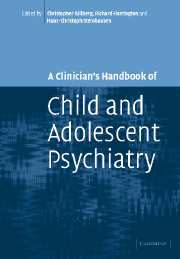Book contents
- Frontmatter
- Contents
- Preface
- List of contributors
- 1 Brain disorders
- 2 Substance use disorders
- 3 Schizophrenia and schizophrenia-like disorders
- 4 Affective disorders
- 5 Anxiety disorders
- 6 Obsessive-compulsive disorders
- 7 Adjustment disorders
- 8 Post-traumatic stress disorder
- 9 Functional somatic symptoms and somatoform disorders in children
- 10 Eating disorders: anorexia nervosa and bulimia nervosa
- 11 Sleep disorders
- 12 Personality disorders
- 13 Mental retardation/learning disability
- 14 Specific developmental disorders of speech and language
- 15 Reading and other learning disorders
- 16 Autism spectrum disorders
- 17 Hyperkinetic disorders
- 18 Conduct disorders
- 19 Elective mutism
- 20 Attachment and disorders of attachment
- 21 Tic disorders
- 22 Elimination disorders: enuresis and encopresis
- 23 Physical and sexual abuse
- 24 Gender identity disorders
- Index
- References
1 - Brain disorders
Published online by Cambridge University Press: 06 August 2009
- Frontmatter
- Contents
- Preface
- List of contributors
- 1 Brain disorders
- 2 Substance use disorders
- 3 Schizophrenia and schizophrenia-like disorders
- 4 Affective disorders
- 5 Anxiety disorders
- 6 Obsessive-compulsive disorders
- 7 Adjustment disorders
- 8 Post-traumatic stress disorder
- 9 Functional somatic symptoms and somatoform disorders in children
- 10 Eating disorders: anorexia nervosa and bulimia nervosa
- 11 Sleep disorders
- 12 Personality disorders
- 13 Mental retardation/learning disability
- 14 Specific developmental disorders of speech and language
- 15 Reading and other learning disorders
- 16 Autism spectrum disorders
- 17 Hyperkinetic disorders
- 18 Conduct disorders
- 19 Elective mutism
- 20 Attachment and disorders of attachment
- 21 Tic disorders
- 22 Elimination disorders: enuresis and encopresis
- 23 Physical and sexual abuse
- 24 Gender identity disorders
- Index
- References
Summary
Introduction
All mental functioning, be it normal or abnormal, is mediated by the brain. Thus, no child and adolescent psychiatric disorder can be thought of as not being brain related. However, there is a separate category of disorders in which the structure of the brain itself is disordered or in which the basic neurological functions are altered so that normal mental functioning may not result. This is most obvious in those disorders that result from morphological alterations of the brain structure due to a noxious agent or event, or due to a neurobiological deficit that seriously affects the organization and development of the brain.
Classification of brain disorder in childhood and adolescence is not very satisfactory. The major classes of brain disorders as set out in the ICD-10 are derived mainly from manifestations of disorders in adulthood with insufficient consideration of developmental aspects in childhood and adolescence. Thus, in contrast to most of the remaining chapter in this volume both ICD-10 and DSM-IV are not considered as the relevant framework for classification of brain disorders in childhood and adolescence.
In this chapter the following major brain disorders with a basic neurological alteration of brain structures and functions will be described: injury, infectious disorder, cerebral palsy, epilepsy and brain tumours. In an additional section the concept of minor brain dysfunction syndromes will be discussed. This concept has been very influential in the past and has largely been ignored in the more recent academic debate in child and adolescent psychiatry.
- Type
- Chapter
- Information
- Publisher: Cambridge University PressPrint publication year: 2006

